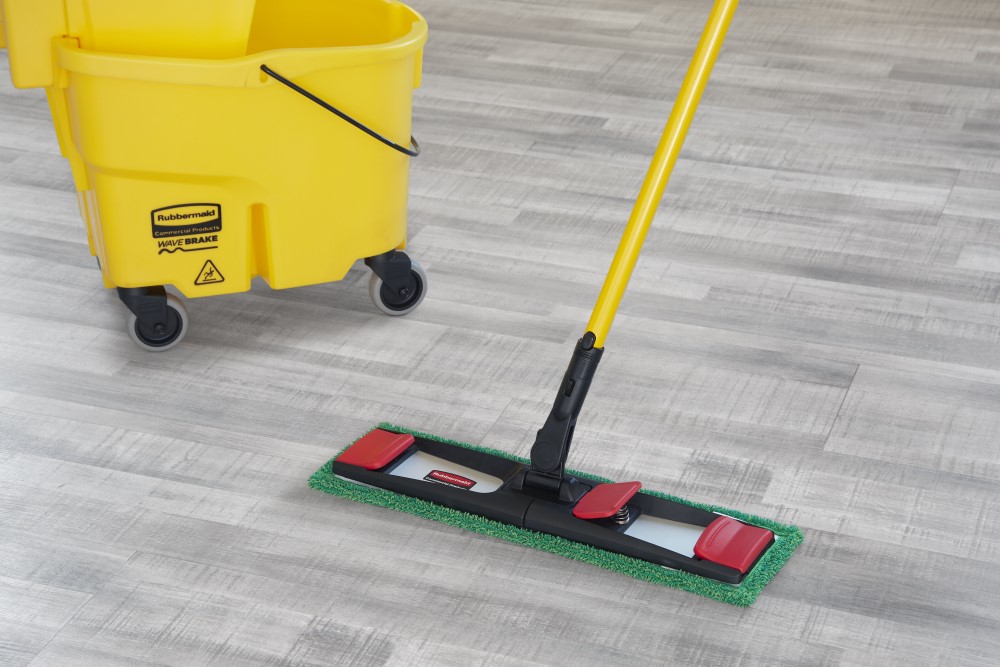
A clean floor is essential to comfortable and safe healthcare, education and hospitality spaces. But, is the floor truly getting clean? If your cleaning team hasn’t washed their trusty mop lately, it might be doing more harm than good.
Read on to learn how to clean various types of mops, how often to clean or replace them and sanitation best practices when it comes to cleaning your company’s floors.
It might seem odd to clean an item that is constantly covered in disinfectant, but bacteria rely on moisture to thrive, according to Better Health Channel. If the mop is put away wet, uncleaned and in a dark closet, it has the potential to spread germs when in use.
So how do you clean and sanitise a mop? The cleaning process depends on the style, but for a regular wet mop follow these standard procedures.
Start by rinsing the dirty mop head under running water until the water clears. Any dirt, grime and bigger dust particles will be washed away in this process.
If your mop head is removable, throw the head into the dishwasher or washing machine. If not, add dish detergent into a bucket and lather the mop head in soapy water before rinsing. This will remove stains and other debris that didn’t come off in the running water.
After all soap is removed, soak the mop in a combination of hot water and bleach or disinfectant for about 10 minutes. Rinse thoroughly.
Wring out all dirty water, detergent or disinfectant to make the drying process quicker.
Situate the mop upright and leave it to dry completely before returning it to a closed container.
As mentioned above, what type of mop your cleaning staff uses affects the cleaning process. A few of the most common types of mops and their sanitation best practices include microfibre mop pads and spin mop heads.
A microfibre flat mop pad is an effective cleaning tool for your company’s floors. To clean a mop pad, remove the pad from the mop and either throw it into the dishwasher or washing machine. If hand washing the pad, use hot water and a gentle detergent. Never use bleach or fabric softener as these disinfectants can break down the material over time. After washing, wring out and air dry thoroughly.
A spin mop head is very similar to a regular wet mop, and the same washing procedures can be used.
Any mop can start to smell after frequent use. To get rid of the odour, add one cup of white vinegar to one gallon of hot water and allow it to soak for a few minutes. After soaking, continue with the cleaning process for a regular wet mop.
To keep a mop dependable, use mopping best practices. This will decrease bacteria growth and save you money from having to constantly replace your cleaning tools.
To prepare, fill a mop bucket with floor cleaning solution and warm water and put a safety sign near the area being cleaned. When mopping the floor, wring the mop head a few times before starting. This will reduce puddles and make it easier to air dry. A good rule of thumb is to wring the mop until it stops dripping. Start in the farthest corner of the room and frame a square-shaped area. With the mop, make a figure 8 motion until the area is fully cleaned — then, move on to the next square-shaped area and repeat until finished.
Afterwards, dump the bucket out — leaving any liquid in the bucket can increase bacteria growth. Clean your mop and set it to dry.
In order to create a comfortable environment, it’s better to be safe than sorry. That means cleaning and replacing the mop heads or mop pads very often.
Your cleaning services team should plan on cleaning the mop after every use. This will keep germs from cross-contaminating and spreading. If a wet mop is used, ensure the last person to use it went through the proper cleaning procedures. Also, ensure that the mop is completely dry. When using a mop that needs a mop pad, retrieve a clean microfibre cloth before getting started.
If the mop head starts to look run down or if you’re unable to remove all stains and blemishes during the cleaning process, it’s time to replace it. Another option is to purchase disposable wet mop heads that can be replaced after every use.
The last step of the cleaning process is one of the most important. According to Safe Work Australia, the less water in an area, the fewer bacteria can grow. That means using a clean, dry mop is a better and safer way to clean.
Try these drying and storing methods.
Learn more tips on how to clean the mop, and discover Rubbermaid Commercial cleaning equipment on our website.